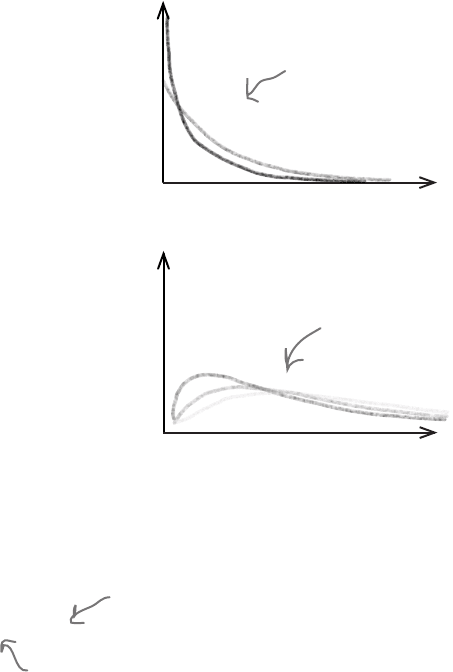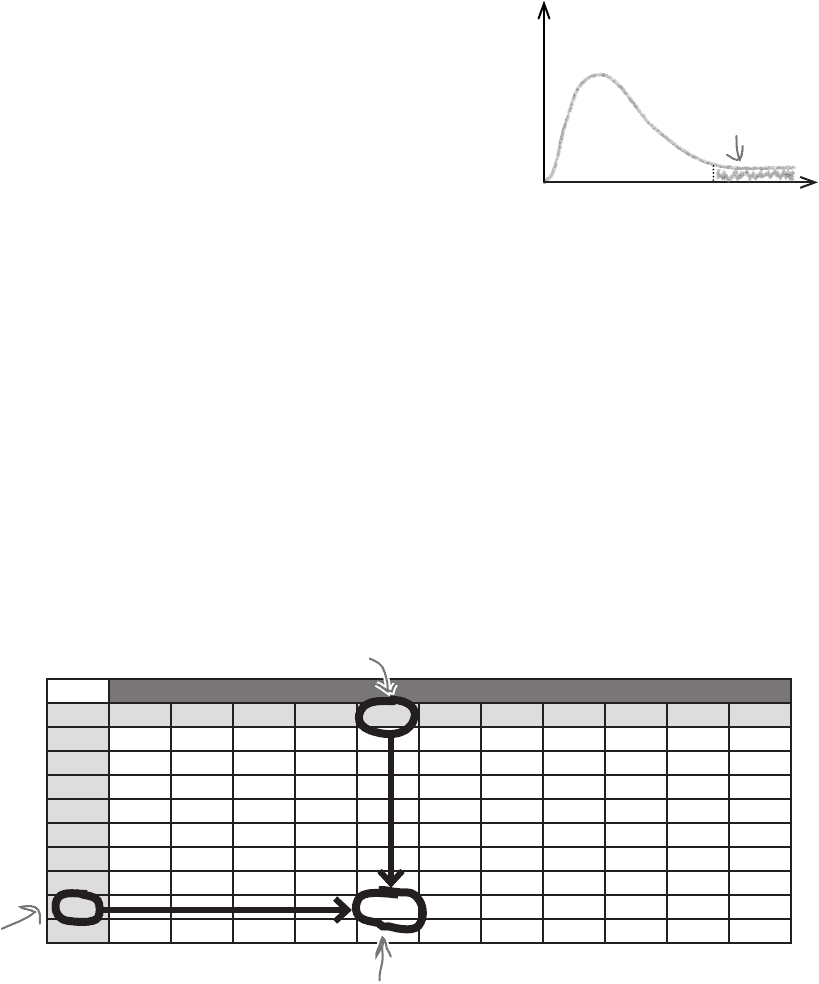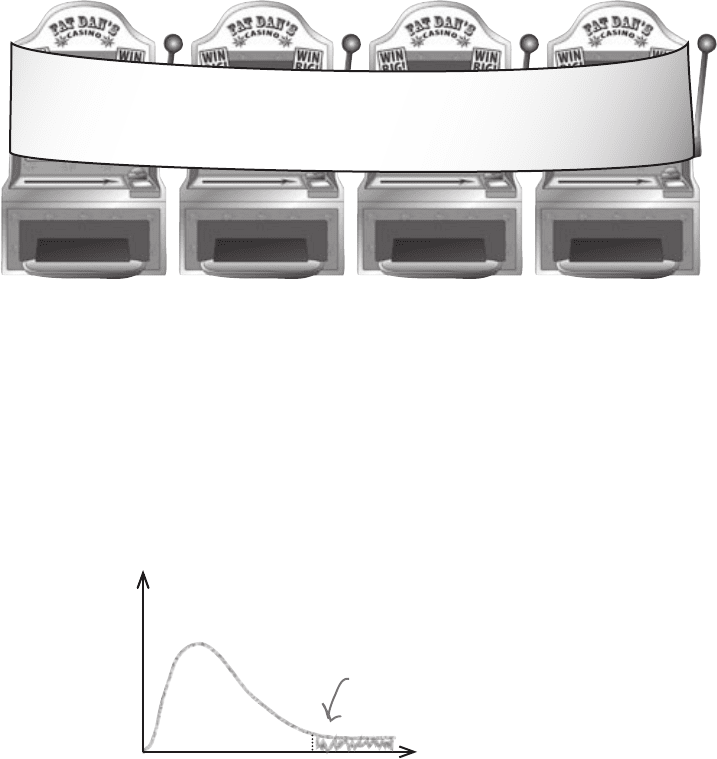Griffiths D. Head First Statistics
Подождите немного. Документ загружается.


you are here 4 571
the χ
2
distribution
The χ
2
test assesses difference
There’s a new sort of probability distribution that does exactly what we want;
it’s called the χ
2
distribution. χ is pronounced “kye”, and it’s the uppercase
Greek letter chi. It uses a test statistic to look at the difference between what
we expect to get and what we actually get, and then returns the probability of
getting observed frequencies as extreme.
Let’s start with the test statistic. To find the test statistic, first make a table
featuring the observed and expected frequencies for your problem. When
you’ve done that, use your observed and expected frequencies to compute the
following statistic, where O stands for the observed frequency, and E for the
expected frequency:
Use the table of observed and expected frequencies you just
worked out on the previous page for Fat Dan’s slot machines to
compute the test statistic. What result do you get?
What do you think a low value tells you? What about a high value?
In other words, for each probability in the probability distribution, you take
the difference between the frequency you expect and the frequency you
actually get. You square the result, divide by the expected frequency, and
then add all of these results up together.
So what’s the test statistic for the slot machine problem?
O refers to the observed frequency, while
E refers to the expected frequency.
Σ
(O - E)
2
E
Χ
2
=

572 Chapter 14
So at what point does Χ
2
become so large that it’s significant? We need to
figure out when we can fairly certain that something’s going on with the slot
machines that’s beyond what could reasonably happen by chance.
To find this out, we need to look at the χ
2
distribution.
Use the table of observed and expected frequencies you just
worked out on the previous page for Fat Dan’s slot machines to
compute the test statistic. What result do you get?
What do you think a low value tells you? What about a high value?
So what does the test statistic represent?
The test statistic Χ
2
gives a way of measuring the difference between the
frequencies we observe and the frequencies we expect. The smaller the value
of Χ
2
, the smaller the difference overall between the observed and expected
frequencies.
You divide by E, the expected frequency, as this makes the result proportional
to the expected frequency.
The smaller the differences between O
and E, the smaller X
2
is.
Dividing by E makes the difference
proportional to the expected frequency.
X
2
= (965 - 977)
2
/977 + (10 - 8)
2
/8 + (9 - 8)
2
/8 + (9 - 6)
2
/6 + (7 - 1)
2
/1
= (-12)
2
/977 + 2
2
/8 + 1
2
/8 + 3
2
/6 + 6
2
= 144/977 + 4/8 + 1/8 + 9/6 + 36
= 0.147 + 0.5 + 0.125 + 1.5 + 36
= 38.272
If the value of X
2
is low, then this means there’s a less significant difference between the observed and expected
frequencies. The higher X
2
is, the more significant the differences become.
another sharpen solution
Σ
(O - E)
2
E
Χ
2
=

you are here 4 573
the χ
2
distribution
Two main uses of the χ
2
distribution
The χ
2
probability distribution specializes in detecting when the results you
get are significantly different from the results you expect. The probability
distribution does this using the Χ
2
test statistic you saw earlier.
The χ
2
distribution has two key purposes.
First of all, it’s used to test goodness of fit. This means that you can use
it to test how well a given set of data fits a specified distribution. As an
example, we can use it to test how well the observed frequencies for the slot
machine winnings fits the distribution we expect.
Another use of the χ
2
distribution is to test the independence of two
variables. It’s a way of checking whether there’s some sort of association.
The χ
2
distribution takes one parameter, the Greek letter ν, pronounced
“new.” Let’s take a look at the effect that ν has on the shape of the
probability distribution.
A shorthand way of saying that you’re using the test statistic Χ
2
with the
χ
2
distribution that has a particular value of ν is
Χ
2
~ χ
2
(ν)
X
2
follows a χ
2
distribution with a given value of ν.
When ν is 1 or 2
When ν has a value of 1 or 2, the shape of the χ
2
distribution
follows a smooth curve, starting off high and getting lower. It’s
shape is like a reverse J. The probability of getting low values of
the test statistic Χ
2
is much higher than getting high values. In
other words, observed frequencies are likely to be close to the
frequency you expect.
When ν is greater than 2
When ν has a value that’s greater than 2, the shape of the χ
2
distribution changes. It starts off low, gets larger, and then
decreases again as Χ
2
increases. The shape is positively skewed,
but when ν is large, it’s approximately normal.
It’s like an X, but curvier.
The χ
2
distribution has this
sort of shape if ν is 1 or 2.
It has this sort of shape if ν
is greater than 2. The larger
ν becomes, the more normal
the χ
2
distribution gets.
χ
2
χ
2

574 Chapter 14
ν = (number of classes) - (number of restrictions)
ν = 5 – 1
= 4
ν represents degrees of freedom
You’ve seen how the shape of the χ
2
distribution depends on the value of ν, but
how do we find what ν is?
ν is the number of degrees of freedom. It’s the number of independent
variables used to calculate the test statistic Χ
2
, or the number of independent
pieces of information. Let’s see what this means in practice.
Here’s another look at the table of observed and expected frequencies for the
slot machines:
The number of degrees of freedom is the number of expected frequencies we
have to calculate, taking into account any restrictions we have upon us.
In order to calculate the test statistic Χ
2
, we had to calculate all of the expected
frequencies. This meant that we had to calculate five expected frequencies.
While calculating this, we had one thing we had to bear in mind: the total
expected frequency and the total observed frequency had to add up to the same
amount. In other words, we had one restriction on us in our calculations.
So what’s ν?
To calculate ν, we take the number of pieces of information we calculated, and
subtract the number of restrictions. To figure out the test statistic Χ
2
, we had to
calculate five separate pieces of information, with 1 restriction. This means that
the number of degrees of freedom is given by
In general,
x Observed frequency Expected frequency
-2
965 977
23
10 8
48
9 8
73
9 6
98
7 1
Another way of looking at this is that we had to calculate four of the expected
frequencies using the probability distribution. We could work out the final
frequency by looking at what the total expected frequency should be.
degrees of freedom

you are here 4 575
the χ
2
distribution
Tail probability α
ν
.25 .20 .15 .10 .05 .025 .02 .01 .005 .0025 .001
1 1.32 1.64 2.07 2.71 3.84 5.02 5.41 6.63 7.88 9.14 10.83
2 2.77 3.22 3.79 4.61 5.99 7.38 7.82 9.21 10.60 11.98 13.82
3 4.11 4.64 5.32 6.25 7.81 9.35 9.84 11.34 12.84 14.32 16.27
4 5.39 5.99 6.74 7.78 9.49 11.14 11.67 13.28 14.86 16.42 18.47
5 6.63 7.29 8.12 9.24 11.07 12.83 13.39 15.09 16.75 18.39 20.51
6 7.84 8.56 9.45 10.64 12.59 14.45 15.03 16.81 18.55 20.25 22.46
7 9.04 9.80 10.75 12.02 14.07 16.01 16.62 18.48 20.28 22.04 24.32
8 10.22 11.03 12.03 13.36 15.51 17.53 18.17 20.09 21.95 23.77 26.12
9 11.39 12.24 13.29 14.68 16.92 19.02 19.68 21.67 23.59 25.46 27.88
What’s the significance?
So how can we use the χ
2
distribution to say how significant the
discrepancy is between the observed and expected frequencies? As
with other hypothesis tests, it all depends on the level of significance.
When you conduct a test using the χ
2
distribution, you conduct a one-
tailed test using the upper tail of the distribution as your critical region.
This way, you can specify the likelihood of your results coming from
the distribution you expect by checking whether the test statistic lies in
the critical region of the upper tail.
If you conduct a test at significance level α, then you write this as
χ
2
α
(ν)
The critical region for testing
at the α significance level lies
in the upper tail. The higher the
value of your test statistic, the
bigger the differences between
your observed and expected
frequencies.
χ
2
α
(ν)
How to use χ
2
probability tables
To find the critical value, start off with the degrees of freedom, ν, and
the significance level, α. Use the first column to look up ν, and the
top row to look up α. The place where they intersect gives the value x,
where P(χ
2
α
(ν) ≥ x) = α. In other words, it gives you the critical value.
As an example, if you wanted to find the critical value for testing at the
5% level with 8 degrees of freedom, you’d find 8 in the first column,
0.05 in the top row, and read off a value of 15.51. In other words, if
our test statistic Χ
2
was greater than 15.51, it would be in the critical
region at the 5% level with 8 degrees of freedom.
Here’s the
row for
ν = 8.
Here’s the column for 0.05.
This is where 8 and 0.05 meet.
So how do we find the critical region for the χ
2
distribution? We can use
χ
2
probability tables.

576 Chapter 14
Hypothesis testing with χ
2
Here are the broad steps that are involved in hypothesis testing with the χ
2
distribution.
Decide on the hypothesis you’re going to test,
and its alternative
Find the expected frequencies and the degrees
of freedom
Calculate the test statistic Χ
2
Determine the critical region for your decision
See whether the test statistic is within the
critical region
Make your decision
Look familiar? Most of these steps are exactly the same as for other
hypothesis tests. In other words, it’s exactly the same process as before.
Q:
So are χ
2
tests really just a special
kind of hypothesis test?
A: Yes, they are. You go through pretty
much all the steps you had to go through
before.
Q:
Do I always use the upper tail for
my test?
A: Yes, if you’re conducting a hypothesis
test, you always use the upper tail. This is
because the higher the value of your χ
2
test
statistic, the more your observed frequencies
differ from the expected frequencies.
Q:
I think I’ve heard the term degrees
of freedom before. Have I?
A: Yes, you have. Remember when we
looked at how we can use the t-distribution
to create confidence intervals? Well, the
t-distribution uses degrees of freedom, too.
Q:
I think I’ve seen degrees of freedom
referred to as df rather than ν. Is that
wrong?
A: Not at all. Different text books use
different conventions, and we’re using ν.
At the end of the day, they have the same
meaning.
Q:
I want to look for information about
the χ
2
distribution on the Internet. How do
I find it? Do I need to type in Greek?
A: You should be able to find any
information you need by searching for the
term “chi square.” The χ
2
distribution is also
written “chi-squared.”
These steps are
just like the ones
we had before
These steps are
different from the
ones you saw before
χ
2
hypothesis testing steps
1
2
6
5
4
3

you are here 4 577
the χ
2
distribution
It’s your job to see whether there’s sufficient evidence at the 5% level to say that the slot
machines have been rigged. We’ll guide you through the steps.
1. What’s the null hypothesis you’re going to test? What’s the alternate hypothesis?
2. There are 4 degrees of freedom. What’s the region for the 5% level?
3. What’s the test statistic?
4. Is your test statistic inside or outside the critical region?
5. Will you accept or reject the null hypothesis?
Hint: You calculated this earlier.

578 Chapter 14
It’s your job to see whether there’s sufficient evidence at the 5% level to say that the slot
machines have been rigged. We’ll guide you through the steps.
1. What’s the null hypothesis you’re going to test? What’s the alternate hypothesis?
2. There are 4 degrees of freedom. What’s the region for the 5% level?
3. What’s the test statistic?
4. Is your test statistic inside or outside the critical region?
5. Will you accept or reject the null hypothesis?
H
0
: The slot machine winnings per game follow the described probability distribution.
H
1
: The slot machine winnings per game do not follow this probability distribution.
From probability tables, χ
2
5%
(4) = 9.49. This means that the critical region is where X
2
> 9.49.
The test statistic is X
2
. You found this earlier; its value is 38.272.
The value of X
2
is 38.27, and as the critical region is X
2
> 9.49, this means that X
2
is inside the critical
region.
The value of X
2
is inside the critical region, so this means that we reject the null hypothesis. In other words,
there is sufficient evidence to reject the hypothesis that the slot machine winnings follow the described
probability distribution.
x -2 23 48 73 98
P(X = x) 0.977 0.008 0.008 0.006 0.001
exercise solution

you are here 4 579
the χ
2
distribution
Let’s summarize the steps you went through to discover this.
First of all, you took a set of observed frequencies for the slot machine and
calculated what you expected the frequencies to be, assuming they followed a
particular probability distribution. You then calculated the degrees of freedom
and calculated the test statistic Χ
2
, which gave you an indication of the total
discrepancy between the observed frequencies and those you expected.
After this, you used the χ
2
probability tables to find the critical region of the
distribution at the 5% level of significance. You checked this against your test
statistic and found that there was sufficient evidence to say that the slot machine
has been rigged to pay out more money.
Your test statistic fell in the critical region,
so you could reject the null hypothesis
This sort of hypothesis test is called a goodness of fit test. It tests whether
observed frequencies actually fit in with an assumed probability distribution.
You use this sort of test whenever you have a set of values that should fit a
distribution, and you want to test whether the data actually does.
You’ve solved the slot machine mystery
Thanks to your careful use of the χ
2
probability distribution, you’ve found out
that there’s sufficient evidence that the slot machine isn’t following the probability
distribution that the casino expects it to. Fat Dan is very grateful to you, as this
means you’ve come up with evidence that the slot machine has been rigged in
some way. He’s shut them down, so he doesn’t lose any more money.
O
u
t
o
f
O
r
d
e
r
χ
2
α
(ν)

580 Chapter 14
Fat Dan thinks that the dice in the dice games are loaded. Take a look at the following
observed frequencies for one six-sided die, and test whether there’s enough evidence to
support the claim that the die isn’t fair at the 1% significance level. We’ll guide you through the
steps.
Here are the observed frequencies:
x Observed frequency Expected frequency
1
107
2
198
3
192
4
125
5
132
6
248
Value 1 2 3 4 5 6
Frequency
107 198 192 125 132 248
Step 1: Decide on the hypothesis you’re going to test, and its alternative.
Step 2: Find the expected frequencies and the degrees of freedom.
Start off by completing the expected frequencies for the die. You’ll need to take into account how many times the die is
thrown in total, and the probability of getting each value. X represents the value of one toss of the die.
Once you’ve found the expected frequencies, what are the number of degrees of freedom?
You find this the same way you
found the degrees of freedom for
the slot machines.
long exercise
